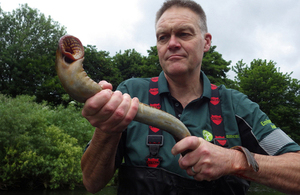Prehistoric fish return to England’s rivers
A prehistoric fish, that was around 200 million years before dinosaurs, has been seen in English rivers for the first time since the 1800s.

Lamprey returning to England’s rivers, thanks to the Environment Agency. Fisheries Technical Officer Paul Frear holding a lamprey.
The world’s oldest living vertebrates, lamprey are snake-like creatures with a circular disc of razor sharp teeth instead of jaws. The largest of the UK lamprey species - the sea lamprey – can grow up to 1 metre in length. Once a common sight in our waterways, river and sea lampreys are now endangered across Europe.
The pollution caused by the Industrial Revolution, along with the construction of mill weirs that blocked their migration, had a devastating effect on their numbers.
But lampreys are slowly returning to their old habitats, thanks to the lowest levels of pollution for more than 100 years and the Environment Agency’s work to remove some river structures like weirs. Where barriers cannot be removed a range of innovative techniques are being trialled, including the fitting of lamprey ‘tiles’, to help them navigate back to their old spawning grounds.
Lamprey tiles are low-cost, low-maintenance tiles with broad cones that enable lamprey to squirm upwards using their sucker-like mouths to anchor themselves. On Buttercrambe Weir on the River Derwent in Yorkshire initial results have been encouraging, and it is hoped that lamprey tiles could help in many more rivers.
Environment Agency fisheries expert Simon Toms said: “For the last 200 hundred years, some rivers have not been capable of supporting lamprey species as a result of water quality, poor habitat and manmade barriers.
“Now that water quality has improved and some of these barriers have been removed we are seeing lampreys return to the upper reaches of rivers such as the Ouse, Trent, and Derwent, where they were absent as recently as 30 years ago.
“These are fascinating fish, living fossils, that have a special place in the history and traditions of this country, and we hope that with a helping hand from us they will be able to thrive in England’s rivers once again.”
Lampreys have been regarded as a luxury food throughout history – they are recorded as being eaten by the Vikings, poached in red wine by the Romans and eaten in lamprey pie by the British monarch on special occasions. King John is said to have fined the City of Gloucester the equivalent of £250,000 for not delivering his Christmas lamprey pie and Queen Elizabeth II was sent a lamprey pie from Gloucester for her diamond jubilee in 2012, though the fish were imported from the Great Lakes in North America.
Lamprey pie also features in the TV series Game of Thrones. In ‘The Prince of Winterfell’ Tyrion Lannister dines on lamprey pie whilst talking over plans for the Battle of the Blackwater with his sister Queen Cersei.
As well as being a fascinating ancient species, lampreys are ecologically important in helping to process nutrients in rivers as well as a food source for fish and birds, such as herons and sawbill ducks.
There are 3 lamprey species found in rivers in England. The brook lamprey, which, as an adult, measures around 15 centimetres, completes its life cycle wholly in freshwater. Like many freshwater fish species, they require clean flowing water in which to spawn and migrate upstream to find suitable spawning habitats.
However, its much larger cousins, river and sea lampreys, migrate to sea where they mature as adults before returning to the river to spawn.